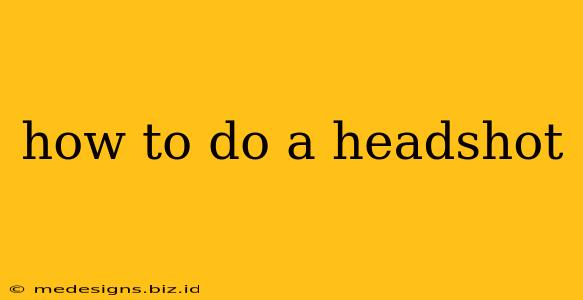So, you need a headshot. Maybe for a new job application, your online dating profile, or simply to update your LinkedIn profile. Whatever the reason, a great headshot can make all the difference. But knowing how to take one that truly captures your best self can be tricky. This guide will walk you through everything you need to know, from planning and preparation to editing and final touches.
Planning Your Headshot: Preparation is Key
Before you even think about pointing your camera, careful planning will significantly improve your results.
1. Defining Your Purpose and Audience:
- What's the goal? Are you aiming for a professional, friendly, approachable, or serious look? The purpose dictates the style. A headshot for a corporate lawyer will differ vastly from one for a freelance artist.
- Who's your audience? Consider who will be seeing your headshot. Tailor your expression and style to resonate with them.
2. Choosing the Right Outfit:
- Simplicity is best: Avoid busy patterns and distracting colors. Solid, neutral tones generally work well.
- Consider your industry: A suit might be appropriate for a corporate setting, but casual attire might be better for a creative field.
- Iron your clothes!: Wrinkles are distracting and unprofessional.
3. Location, Location, Location:
- Background matters: A clean, uncluttered background is crucial. Avoid busy patterns or anything that might draw attention away from you. A plain wall or a softly blurred outdoor setting works well.
- Lighting is everything: Natural light is ideal. Shoot outdoors in soft, diffused light (avoid harsh midday sun). Indoors, position yourself near a window for soft, even illumination.
Taking the Shot: Technical Aspects
Now for the technical side of things. Even with a smartphone, you can achieve professional-looking results with the right technique.
1. Equipment:
- Camera: A DSLR or mirrorless camera will give you the best results, but a smartphone camera can work well too, especially with good lighting.
- Lens: A 50mm or 85mm lens is ideal for headshots, but you can use your smartphone's default lens.
- Tripod (Optional but recommended): A tripod will help you avoid blurry images and ensure consistent framing.
2. Camera Settings:
- Aperture: A wider aperture (lower f-stop number, like f/2.8 or f/4) will blur the background and focus attention on you.
- ISO: Keep your ISO as low as possible to avoid noise (grain) in your image.
- Shutter speed: Use a shutter speed fast enough to avoid motion blur.
3. Posing and Expression:
- Posture: Stand tall with good posture. Slightly tilting your head can create a more engaging look.
- Expression: Practice different expressions in the mirror beforehand to find one that feels natural and represents you well. A genuine smile is usually a good choice.
- Eyes: Make sure your eyes are focused on the camera.
Editing Your Headshot: Polishing the Final Product
Even the best shot benefits from some post-processing.
1. Basic Adjustments:
- Cropping: Crop your image to the desired aspect ratio (usually a square or slightly vertical).
- Brightness and Contrast: Adjust brightness and contrast to optimize the image's overall look.
- Sharpness: Sharpen your image slightly to enhance detail.
2. Advanced Editing (Optional):
- Retouching: Subtle retouching can remove blemishes or minor imperfections. Avoid overdoing it, though—you still want to look like yourself!
- Color Correction: Ensure your skin tones are accurate and natural.
Beyond the Basics: Tips for Success
- Multiple shots: Take many photos and choose the best one.
- Get feedback: Ask friends or family for their opinion on your shots.
- Professional help: If you're unsure, consider hiring a professional photographer. They have the expertise and equipment to get the best results.
By following these steps, you can create a headshot that truly represents you and makes a great first impression. Remember, a great headshot isn't just about technical skill; it's also about conveying your personality and professionalism. Good luck!
